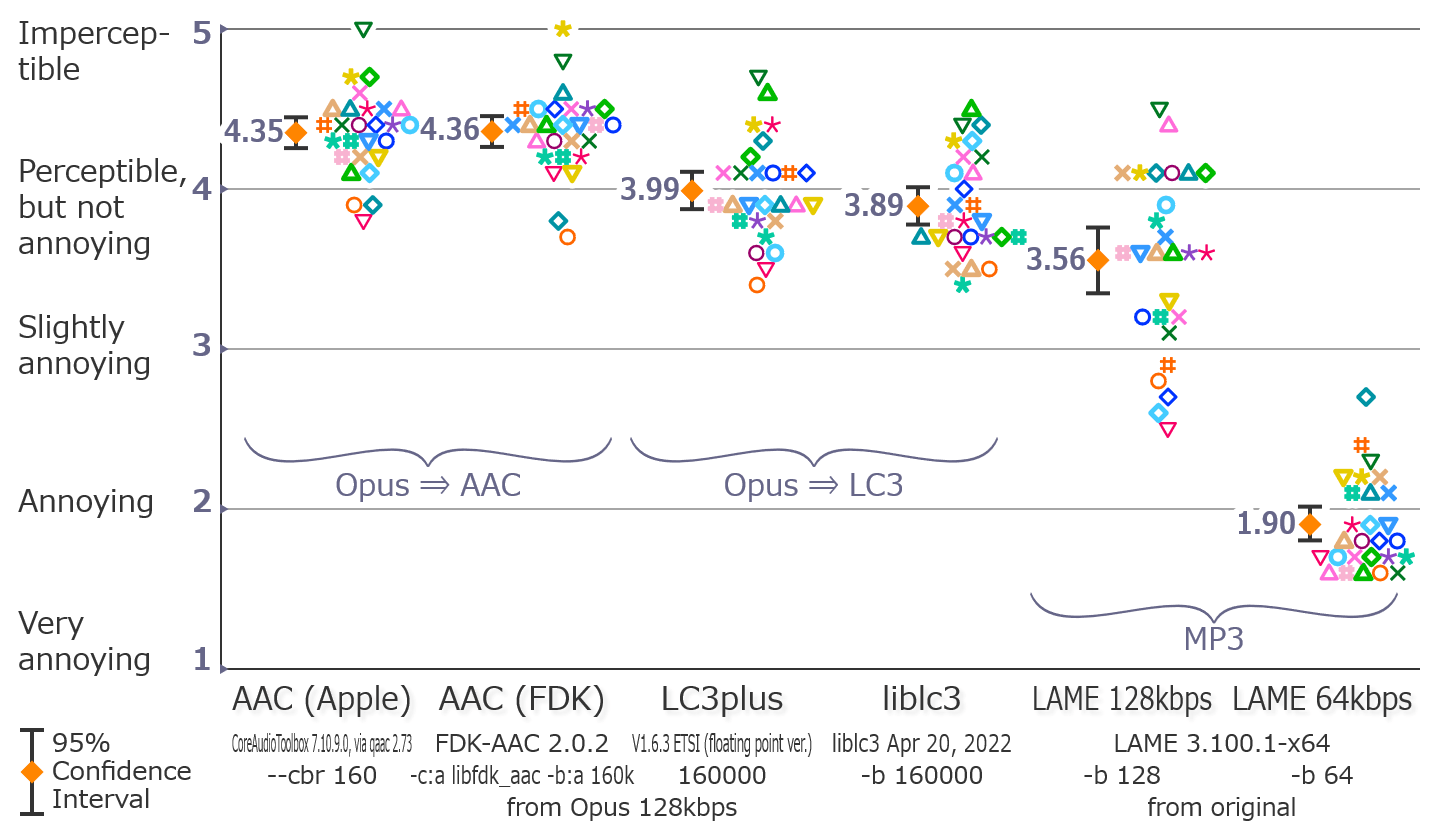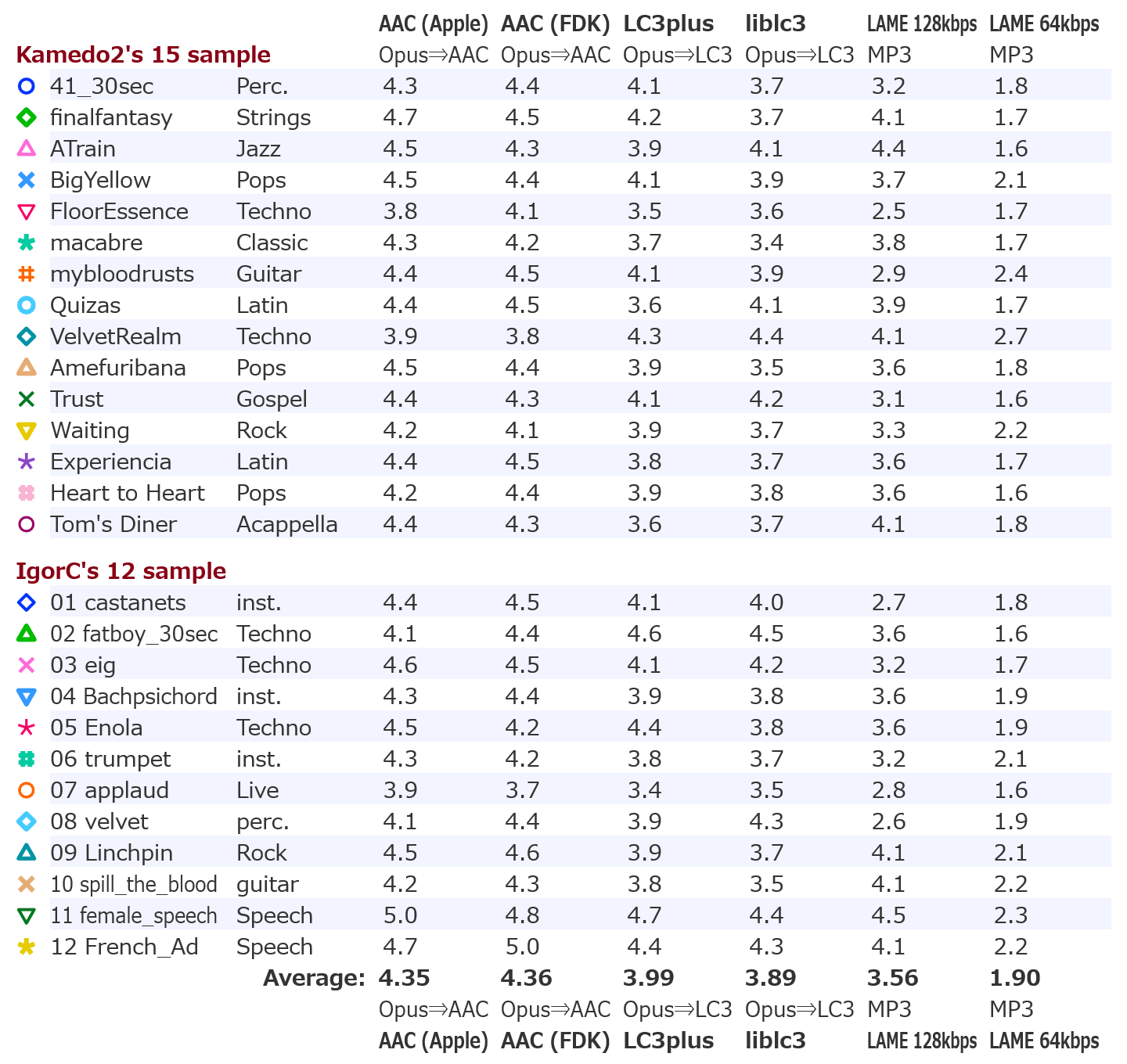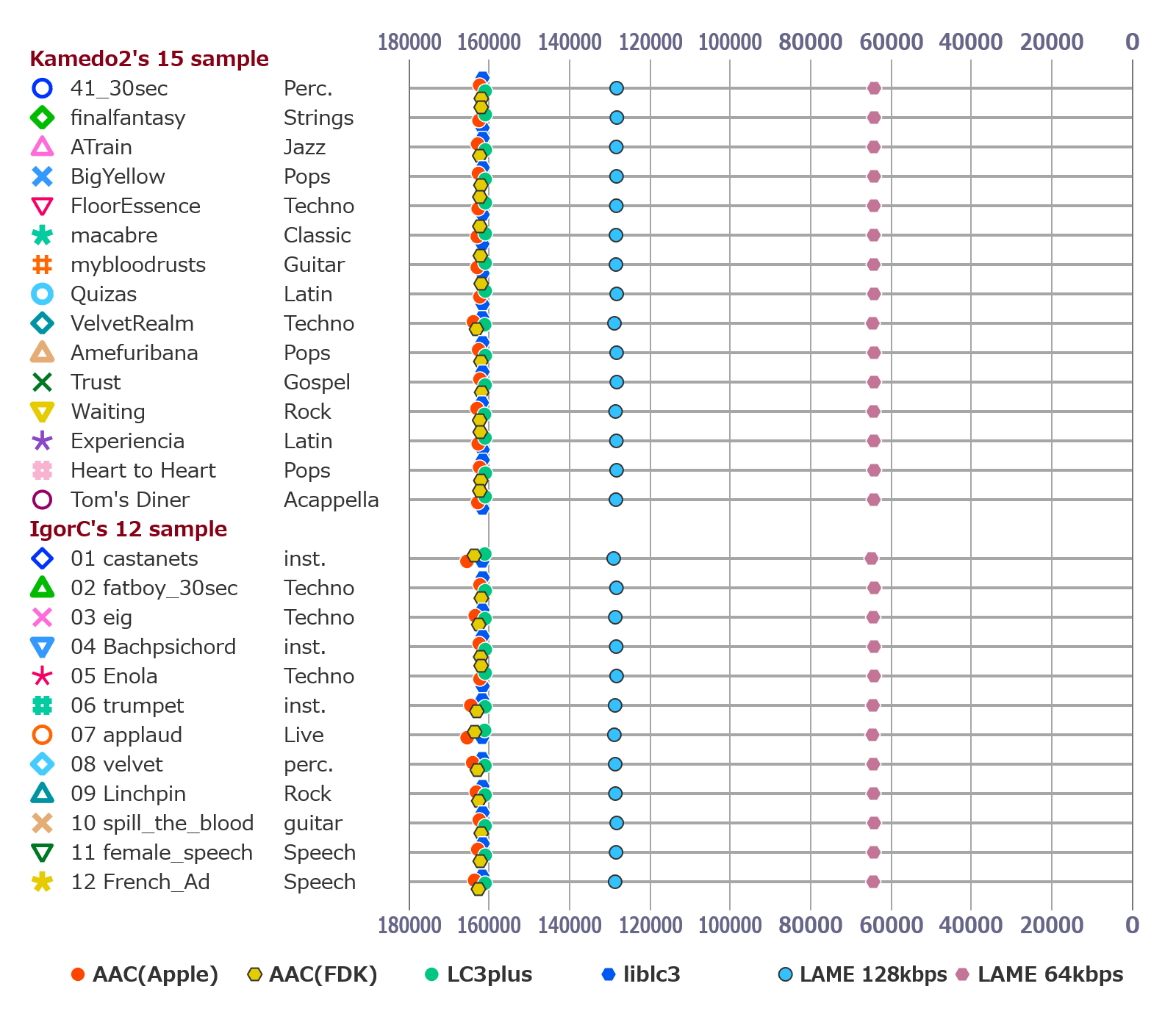Abstract:
Personal blind sound quality comparison of the Bluetooth codec, AAC and LC3, at 160 kbps, at 44.1 kHz(except for liblc3).
As of 2022, Bluetooth earphones and speakers often support AAC codec.
LC3 is a new codec, which will be mandatory in the upcoming LE Audio in Bluetooth 5.2.
Two AAC encoders were tested; one engine is CoreAudio, used by the Apple, and the other engine, FDK-AAC is used by the Android.
Two LC3 encoders were tested; the latest LC3plus encoder available from ESTI, and google / liblc3, which is actively developed by Antoine SOULIER as of June 2022.
The original lossless tracks were first encoded by Opus 128 kbps, decoded, and then re-encoded by the AAC and LC3. This is meant to replicate how online streaming services are used with Bluetooth.
MP3 encoded with LAME CBR was also tested, as anchors. MP3 was directly encoded from the original, not from Opus.
Encoders:
Opus 1.3 via opus-tools-0.2
CoreAudioToolbox 7.10.9.0, via qaac 2.73 (x64 version).
FDK-AAC 2.0.2, via ffmpeg version N-102573-g9d4c018497.
LC3plus Floating Point Software V1.6.3ETSI, ETSI TS 103 634 V1.3.1.
google / liblc3, Apr 20, 2022 version (older version, as of June 2022).
Opus settings:
opus-tools-0.2-opus-1.3\opusenc --bitrate 128 in.wav temp.opus
opus-tools-0.2-opus-1.3\opusdec --float --quiet temp.opus temp.wav
qaac_2.73\x64\refalac64 temp.wav --rate 48000 -D -b 16 -o temp.48kHz.wav
qaac_2.73\x64\refalac64 temp.wav --rate 44100 -D -b 16 -o temp.44kHz.wav
Opus ⇒ AAC Settings:
qaac_2.73\x64\qaac64 --cbr 160 -o out.mp4 temp.44kHz.wav
ffmpeg102573 -y -i temp.44kHz.wav -c:a libfdk_aac -b:a 160k out.mp4
Opus ⇒ LC3 Settings:
LC3plus -E -q -v temp.44kHz.wav out.lc3 160000
liblc3\bin\elc3 -b 160000 temp.48kHz.wav out.lc3
MP3 Settings:
lame3.100.1-x64\lame -b 128 in.wav out.mp3
lame3.100.1-x64\lame -b 64 in.wav out.mp3
Sample tracks:
15 sound samples from Kamedo2's samples.
12 sound samples from IgorC's samples.
Total 27 diverse music and speech sound samples.
Hardware:
Sony PSP-3000 + RP-HJE150.
Results (AAC and LC3 only):

Results (including MP3):


Conclusions & Observations:
- AAC offered very high fidelity at 160 kbps. Most scores were better than 4.0 (Perceptible, but not annoying) in this particular situation. So were Opus.
- LC3 encoder, provided by ESTI, did not offered fidelity comparable to the commonly used AAC codec at 160k in this particular situation.
- LC3 encoder, developed by Google, did not offered fidelity comparable to the commonly used AAC codec at 160k in this particular situation.
- It's not clear which LC3 encoder was better from this test alone.
- An original track first encoded by Opus 128kbps, decoded, then re-encoded by LC3plus is still better than the LAME MP3 CBR 128kbps encoded once.
Anova analysis:
FRIEDMAN version 1.24 (Jan 17, 2002) http://ff123.net/
Blocked ANOVA analysis
Number of listeners: 27
Critical significance: 0.05
Significance of data: 0.00E+000 (highly significant)
---------------------------------------------------------------
ANOVA Table for Randomized Block Designs Using Ratings
Source of Degrees Sum of Mean
variation of Freedom squares Square F p
Total 161 132.90
Testers (blocks) 26 7.81
Codecs eval'd 5 114.05 22.81 268.52 0.00E+000
Error 130 11.04 0.08
---------------------------------------------------------------
Fisher's protected LSD for ANOVA: 0.157
Means:
AAC(FDK) AAC(Appl LC3plus liblc3 LAMECBR1 LAMECBR6
4.36 4.35 3.99 3.89 3.56 1.90
---------------------------- p-value Matrix ---------------------------
AAC(Appl LC3plus liblc3 LAMECBR1 LAMECBR6
AAC(FDK) 0.926 0.000* 0.000* 0.000* 0.000*
AAC(Appl 0.000* 0.000* 0.000* 0.000*
LC3plus 0.227 0.000* 0.000*
liblc3 0.000* 0.000*
LAMECBR1 0.000*
-----------------------------------------------------------------------
AAC(FDK) is better than LC3plus, liblc3, LAMECBR128kbps, LAMECBR64kbps
AAC(Apple) is better than LC3plus, liblc3, LAMECBR128kbps, LAMECBR64kbps
LC3plus is better than LAMECBR128kbps, LAMECBR64kbps
liblc3 is better than LAMECBR128kbps, LAMECBR64kbps
LAMECBR128kbps is better than LAMECBR64kbps
FRIEDMAN version 1.24 (Jan 17, 2002) http://ff123.net/
Friedman Analysis
Number of listeners: 27
Critical significance: 0.05
Significance of data: 0.00E+000 (highly significant)
Fisher's protected LSD for rank sums: 26.945
Ranksums:
AAC(Appl AAC(FDK) LC3plus liblc3 LAMECBR1 LAMECBR6
143.00 141.00 98.00 87.00 71.00 27.00
---------------------------- p-value Matrix ---------------------------
AAC(FDK) LC3plus liblc3 LAMECBR1 LAMECBR6
AAC(Appl 0.884 0.001* 0.000* 0.000* 0.000*
AAC(FDK) 0.002* 0.000* 0.000* 0.000*
LC3plus 0.424 0.050* 0.000*
liblc3 0.244 0.000*
LAMECBR1 0.001*
-----------------------------------------------------------------------
AAC(Apple) is better than LC3plus, liblc3, LAMECBR128kbps, LAMECBR64kbps
AAC(FDK) is better than LC3plus, liblc3, LAMECBR128kbps, LAMECBR64kbps
LC3plus is better than LAMECBR128kbps, LAMECBR64kbps
liblc3 is better than LAMECBR64kbps
LAMECBR128kbps is better than LAMECBR64kbps
Raw data:
AAC (Apple) AAC (FDK) LC3plus liblc3 LAME 128kbps LAME 64kbps
%feature 5 Opus ⇒ AAC Opus ⇒ AAC Opus ⇒ LC3 Opus ⇒ LC3
%feature 7 MP3 MP3
%feature 10 CoreAudioToolbox 7.10.9.0, via qaac 2.72 FDK-AAC 2.0.2 V1.6.3 ETSI (floating point ver.) liblc3 Apr 20, 2022 LAME 3.100.1-x64 LAME 3.100.1-x64
%feature 11 --cbr 160 -c:a libfdk_aac -b:a 160k 160000 -b 160000 -b 128 -b 64
%feature 12 from Opus 128kbps from Opus 128kbps from Opus 128kbps from Opus 128kbps from original from original
%genre Kamedo2's 15 sample
4.300 4.400 4.100 3.700 3.200 1.800
4.700 4.500 4.200 3.700 4.100 1.700
4.500 4.300 3.900 4.100 4.400 1.600
4.500 4.400 4.100 3.900 3.700 2.100
3.800 4.100 3.500 3.600 2.500 1.700
4.300 4.200 3.700 3.400 3.800 1.700
4.400 4.500 4.100 3.900 2.900 2.400
4.400 4.500 3.600 4.100 3.900 1.700
3.900 3.800 4.300 4.400 4.100 2.700
4.500 4.400 3.900 3.500 3.600 1.800
4.400 4.300 4.100 4.200 3.100 1.600
4.200 4.100 3.900 3.700 3.300 2.200
4.400 4.500 3.800 3.700 3.600 1.700
4.200 4.400 3.900 3.800 3.600 1.600
4.400 4.300 3.600 3.700 4.100 1.800
%genre IgorC's 12 sample
4.400 4.500 4.100 4.000 2.700 1.800
4.100 4.400 4.600 4.500 3.600 1.600
4.600 4.500 4.100 4.200 3.200 1.700
4.300 4.400 3.900 3.800 3.600 1.900
4.500 4.200 4.400 3.800 3.600 1.900
4.300 4.200 3.800 3.700 3.200 2.100
3.900 3.700 3.400 3.500 2.800 1.600
4.100 4.400 3.900 4.300 2.600 1.900
4.500 4.600 3.900 3.700 4.100 2.100
4.200 4.300 3.800 3.500 4.100 2.200
5.000 4.800 4.700 4.400 4.500 2.300
4.700 5.000 4.400 4.300 4.100 2.200
%samples 41_30sec Perc.
%samples finalfantasy Strings
%samples ATrain Jazz
%samples BigYellow Pops
%samples FloorEssence Techno
%samples macabre Classic
%samples mybloodrusts Guitar
%samples Quizas Latin
%samples VelvetRealm Techno
%samples Amefuribana Pops
%samples Trust Gospel
%samples Waiting Rock
%samples Experiencia Latin
%samples Heart to Heart Pops
%samples Tom's Diner Acappella
%samples 01 castanets inst.
%samples 02 fatboy_30sec Techno
%samples 03 eig Techno
%samples 04 Bachpsichord inst.
%samples 05 Enola Techno
%samples 06 trumpet inst.
%samples 07 applaud Live
%samples 08 velvet perc.
%samples 09 Linchpin Rock
%samples 10 spill_the_blood guitar
%samples 11 female_speech Speech
%samples 12 French_Ad Speech
Bitrates:
All encoders were tested with CBR settings, therefore every tracks of AAC and LC3 is very close to 160kbps.

%bitrate
AAC (Apple) AAC (FDK) LC3plus liblc3 LAME CBR 128kbps LAME CBR 64kbps
162387 161978 161014 161659 128285 64154
162562 162020 160979 161667 128230 64196
162879 162365 160984 161655 128372 64266
162679 162084 161015 161646 128319 64214
162749 162340 160981 161652 128368 64267
162989 162338 160987 161719 128440 64278
162974 162222 161016 161679 128458 64286
162331 162011 160989 161658 128271 64202
163932 163180 161141 161773 128827 64534
162628 162092 160980 161683 128295 64199
162327 161897 161024 161667 128244 64205
163037 162391 161182 161834 128553 64319
162736 162244 161050 161634 128353 64260
162391 162100 160983 161628 128304 64185
162832 162343 161019 161702 128470 64276
165547 163738 161116 161762 129023 64827
162311 161976 161009 161624 128336 64161
163482 162617 161070 161709 128613 64406
162476 162136 160979 161669 128396 64204
162317 162027 161015 161648 128300 64203
164590 163095 161051 161759 128666 64466
165505 163638 161164 161773 128851 64589
164116 162966 161075 161768 128639 64396
163213 162632 161036 161696 128588 64332
162477 162004 161025 161649 128264 64195
162842 162243 160988 161630 128432 64282
163657 162689 161047 161716 128663 64396
Other tests:
 Topic: Personal blind comparison of the Bluetooth codecs, AAC vs LC3, re-encoding (Read 28667 times)
previous topic - next topic
Topic: Personal blind comparison of the Bluetooth codecs, AAC vs LC3, re-encoding (Read 28667 times)
previous topic - next topic